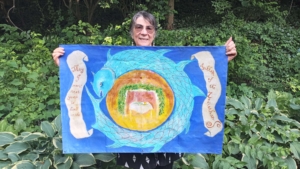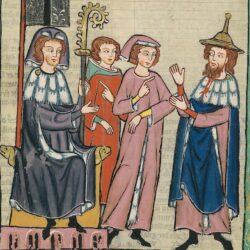Contributor(s): Shared on: Categories: Tags:
A tale told in the short midrash known as Midrash Konen, has it that on the second day of creation the loving embrace of two primordial lovers filled the cosmos, described in Genesis as the waters Above and Below. Nothing more could be done until the two were forcibly separated. And so they were. Creation continued, and here we are. But at the end of days, when this world will come to an end, another tale has it that the two will be reunited. In that story, the upper and lower waters have been re-imagined as enormous, powerful entities, the Behemōt (English: Behemoth, also referred to as the Shor haBor, the Ox of the Great Cistern) and the Leviyatan (English: Leviathan, Yiddish: Levyoson, elsewhere called Tiamat). Their primordial origins remain strongly hinted at in their descriptions in the Talmud, Behemoth associated with the fresh waters precipitating from the sky above and Leviyatan associated with the unfathomably vast saltwater ocean filling the great abyss below. Leviyatan drinks from freshwater lakes and tributaries; her skin and her enormous eyes are strangely luminous, an attribute born surely of her proximity to the genesis of light itself on the first day of creation. Together, these embodiments of water represent the familiar chaos of water flowing forcefully, dangerously in every direction. The power of the divine Artisan is in directing their flow, suspending for a moment turbulence and turmoil, allowing for the possibility of new refractions of primordial creations to emerge. And this is the meaning of the symbol of the Leviyatan in a prayer first recorded in the name of Rabbi Meir of Rothenburg (1215-1293) at the commencement of Shemini Atseret, the day of the prayer for plentiful and beneficial precipitation over the course of the wet season. In a familiar synagogue and cemetery motif found in Podolia, the Leviyatan is illustrated in a fashion similar to that of an ouroboros. But rather than consuming itself, its head holds its tail, symbolizing continuity between the years and Shalom (wholeness and peace) encircling our world. The sukkah of the Leviyatan is a sanctuary of peace in this violent, capricious, and predatory world, a sukkah we must strive to build now, before the end of days. The Leviyatan holding its tail is a grace fully realized in the nature of the coming world where all manage to exist without harm, as it is written, “They shall not hurt nor destroy in all my holy mountain; for the earth shall be full of the knowledge of Hashem, as the waters cover the sea” (Isaiah 11:9). May every faculty of our perception be opened to the awareness of the divinity suffusing all of creation such that we can no longer imagine causing any harm to any being anymore. —Aharon Varady
| Source (Hebrew) | Translation (English) |
|---|
וה״רם היה נוהג
בליל מוצאי סכות
לעלות לסכה
ונוטל רשות ממנה ואומר |
And it was the practice of Maharam of Rothenburg
on the night of the departure of Sukkot
to rise up into the Sukkah
and to request permission of her, saying: |
יְהִי רָצוֹן
שֶׁנִּזְכֶּה לְשָׁנָה הַבָּאָה
לֵשֵׁב בְּסֻכָּה שֶׁל לִוְיָתָן |
May it be your will
that we merit in the coming year
to dwell in the sukkah of the Livyatan |
This formula for recitation in the Sukkah at the conclusion of Sukkot (on the night of Shemini Atseret) is given in the name of Rabbi Meir of Rothenburg (1215-1293) and found in two sources: Siman 148 of the Teshuvot of Shimshon bar Tsadoq (a/k/a the Tashbets), and Siman 71.50 of the Sefer Kol Bo. (Thanks to Yakov Ellenbogen for providing the reference to the Tashbets.) The text provided here is that found in the Kol Bo. I have added niqud to the Hebrew. The formula is slightly different in the Tashbets, omitting the word “leshev”: ולעולם במוצאי סוכות הולך בסוכה ונוטל רשות ממנה ואומר יהי רצון שנזכה בשנה הבאה לסוכה של לויתן:. Below is the expanded formula as found in the Siddur Derekh heḤayyim (1838), p. 521: | Source (Hebrew) | Translation (English) |
|---|
יְהִי רָצוֹן מִלְּפָנֶיךָ
ה׳ אֱלֹהֵינוּ
וֵאלֹהֵי אֲבוֹתֵינוּ
כְּשֵׁם שֶׁקִיַּמְתִּי
וְיָשַׁבְתִּי בְּסוּכָּה זוּ
כֵּן אֶזְכֶּה לְשָׁנָה הַבָּאָה
לֵישֵׁב בְּסוּכָּה שֶׁל לִוְיָתָן׃ |
May it be your will
Hashem our elo’ah
and elo’ah of our ancestors
that just as I have fulfilled (the mitsvah)
and dwelled in this sukkah,
so may I merit in the coming year
to dwell within the sukkah of the Livyatan. |
Source(s) Sefer Kol Bo (1567 ed.) 80b, left column, bottom  Sefer Tashbets (Teshuvot Shimon bar Tsadoq) no. 148 (ed. Warsaw 1902)  Siddur Derekh heHayyim (1838) p. 521
Meir of Rothenburg (c. 1215 – 2 May 1293) was a German Rabbi and poet, as well as a major contributing author of the tosafot on Rashi's commentary on the Talmud. He is also known as Meir ben Baruch (Hebrew: מאיר ב"ר ברוך), and by the Hebrew language acronym Maharam of Rothenburg ("Our Teacher, Rabbi Meir", Hebrew: מהר"ם מרוטנבורג). He was referred to by Rabbi Menachem Meiri as the "greatest Jewish leader of Tsarfat (Medieval Hebrew for France, a reference to Charlemagne's rule of Germany)" alive at the time. Aharon Varady (M.A.J.Ed./JTSA Davidson) is a volunteer transcriber for the Open Siddur Project. If you find any mistakes in his transcriptions, please let him know. Shgiyot mi yavin; Ministarot naqeni שְׁגִיאוֹת מִי־יָבִין; מִנִּסְתָּרוֹת נַקֵּנִי "Who can know all one's flaws? From hidden errors, correct me" (Psalms 19:13). If you'd like to directly support his work, please consider donating via his Patreon account. (Varady also translates prayers and contributes his own original work besides serving as the primary shammes of the Open Siddur Project and its website, opensiddur.org.) Aharon Varady (M.A.J.Ed./JTSA Davidson) is a volunteer translator for the Open Siddur Project. If you find any mistakes in his translations, please let him know. Shgiyot mi yavin; Ministarot Naqeni שְׁגִיאוֹת מִי־יָבִין; מִנִּסְתָּרוֹת נַקֵּנִי "Who can know all one's flaws? From hidden errors, correct me" (Psalms 19:13). If you'd like to directly support his work, please consider donating via his Patreon account. (Varady also transcribes prayers and contributes his own original work besides serving as the primary shammes for the Open Siddur Project and its website, opensiddur.org.) Read a comment / Leave a comment (moderated) Works of related interest: |













Leave a Reply